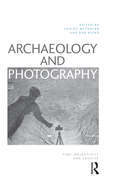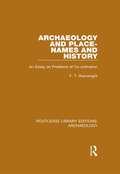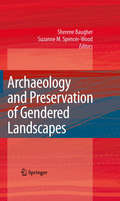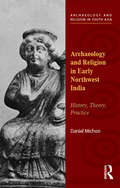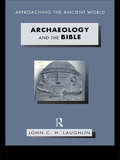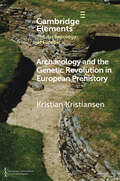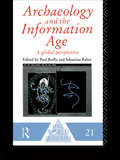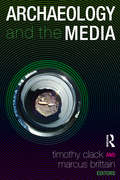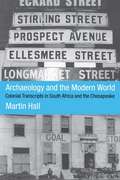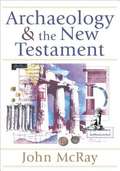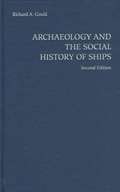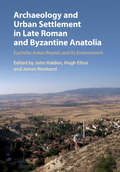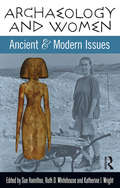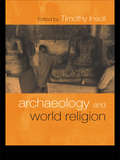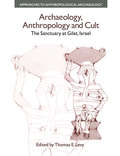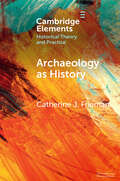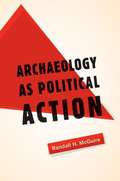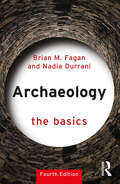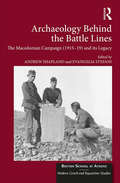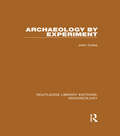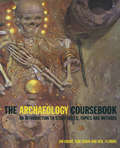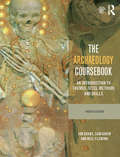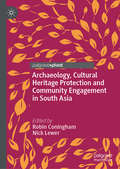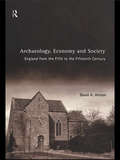- Table View
- List View
Archaeology and Photography: Time, Objectivity and Archive
by Lesley McFADYENDoes a photograph freeze a moment of time? What does it mean to treat a photographic image as an artefact? In the visual culture of the 21st century, do new digital and social forms change the status of photography as archival or objective – or are they revealing something more fundamental about photography’s longstanding relationships with time and knowledge?Archaeology and Photography imagines a new kind of Visual Archaeology that tackles these questions. The book reassesses the central place of Photography as an archaeological method, and re-wires our cross-disciplinary conceptions of time, objectivity and archives, from the History of Art to the History of Science.Through twelve new wide-ranging and challenging studies from an emerging generation of archaeological thinkers, Archaeology and Photography introduces new approaches to historical photographs in museums and to contemporaryphotographic practice in the field. The book re-frames the relationship between Photography and Archaeology, past and present, as more than a metaphor or an analogy – but a shared vision.Archaeology and Photography calls for a change in how we think about photography and time. It argues that new archaeological accounts of duration and presence can replace older conceptions of the photograph as a snapshot orremnant received in the present. The book challenges us to imagine Photography, like Archaeology, not as a representation of the past and the reception of traces in the present but as an ongoing transformation of objectivity and archive.Archaeology and Photography will prove indispensable to students, researchers and practitioners in History, Photography, Art, Archaeology, Anthropology, Science and Technology Studies and Museum and Heritage Studies.
Archaeology and Place-Names and History: An Essay on Problems of Co-ordination (Routledge Library Editions: Archaeology)
by F.T. WainwrightIn the period A.D. 400-1100, perhaps more than in any other, it is necessary to bring together the results of historical, archaeological and place-name studies. Each provides information that is either badly preserved or not preserved at all in the other two, but it is not always realised how great are the difficulties involves in co-ordination and integration. This book, originally published in 1962, draws attention to the problems and provides a basis for discussion.
Archaeology and Preservation of Gendered Landscapes
by Suzanne M. Spencer-Wood Sherene BaugherHistorical archaeology of landscapes initially followed the pattern of Classical Archaeology by studying elite men's gardens. Over time, particularly in North America, the field has expanded to cover larger settlement areas, but still often with ungendered and elite focus. The editors of this volume seek to fill this important gap in the literature by presenting studies of gendered power dynamics and their effect on minority groups in North America. Case studies presented include communities of Native Americans, African Americans, multi-ethnic groups, religious communities, and industrial communities. Just as the research focus has previously neglected the groups presented here, so too has funding to preserve important archaeological sites. As the contributors to this important volume present a new framework for understanding the archaeology of religious and social minority groups, they also demonstrate the importance of preserving the cultural landscapes, particularly of minority groups, from destruction by the modern dominant culture. A full and complete picture of cultural preservation has to include all of the groups that interacted form it.
Archaeology and Religion in Early Northwest India: History, Theory, Practice (Archaeology and Religion in South Asia)
by Daniel MichonThis book explores the ways in which past cultures have been used to shape colonial and postcolonial cultural identities. It provides a theoretical framework to understand these processes, and offers illustrative case studies in which the agency of ancient peoples, rather than the desires of antiquarians and archaeologists, is brought to the fore.
Archaeology and the Bible (Approaching the Ancient World)
by John LaughlinThis book challenges readers to consider whether archaeology explains the Bible.Archaeology and the Bible examines new developments in archaeological finds in the Near East, particularly Palestine, that are related to the Bible. New methodologies, regional surveys and creative syntheses have all had an impact on traditional approaches to looking at these discoveries. John Laughlin examines these new developments and discusses what they imply for biblical studies.
Archaeology and the Genetic Revolution in European Prehistory (Elements in the Archaeology of Europe)
by Kristian KristiansenThis Element was written to meet the theoretical and methodological challenge raised by the third science revolution and its implications for how to study and interpret European prehistory. The first section is therefore devoted to a historical and theoretical discussion of how to practice interdisciplinarity in this new age, and following from that, how to define some crucial, but undertheorized categories, such as culture, ethnicity and various forms of migration. The author thus integrates the new results from archaeogenetics into an archaeological frame of reference, to produce a new and theoretically informed historical narrative, one that also invites debate, but also one that identifies areas of uncertainty, where more research is needed.
Archaeology and the Information Age (One World Archaeology)
by Paul Reilly Sebastian RahtzTraditional methods of making archaeological data available are becoming increasingly inadequate. Thanks to improved techniques for examining data from multiple viewpoints, archaeologists are now in a position to record different kinds of data, and to explore that data more fully than ever before. The growing availablility of computer networks and other technologies means that communication should become increasingly available to international archaeologists. Will this result in the democratisation of archaeological knowledge on a global basis? Contributors from Western and Eastern Europe, the Far East, Africa and the Americas seek to answer this and other questions about the way in which modern technology is revolutionising archaeological knowledge.
Archaeology and the Media (UCL Institute of Archaeology Publications)
by Timothy Clack Marcus BrittainThe public’s fascination with archaeology has meant that archaeologists have had to deal with media more regularly than other scholarly disciplines. How archaeologists communicate their research to the public through the media and how the media view archaeologists has become an important feature in the contemporary world of academic and professional archaeologists. In this volume, a group of archaeologists, many with media backgrounds, address the wide range of questions in this intersection of fields. An array of media forms are covered including television, film, photography, the popular press, art, video games, radio and digital media with a focus on the overriding question: What are the long-term implications of the increasing exposure through and reliance upon media forms for archaeology in the contemporary world? The volume will be of interest to archaeologists and those teaching public archaeology courses.
Archaeology and the Modern World: Colonial Transcripts in South Africa and Chesapeake
by Martin HallArchaeology and the Modern World advances a new controversial theory of historical archaeology. Using new case studies, Martin Hall evaluates the major theoretical traditions in historical archaeology while contributing significantly to the debate. In this study the author places an emphasis on material culture and the recent past to bring to light a picture of an unstable and violent early colonial world in which material culture played a crucial mediating role.
Archaeology and the New Testament
by John McRayAs he tours sites associated with the ministry of Jesus, the journey of Paul, and the seven churches of Revelation, he shows the pervasive influence of society, architecture, and religion on the peoples of the first century and on the New Testament.
Archaeology and the Senses
by Yannis HamilakisThis book is an exciting new look at how archaeology has dealt with the bodily senses and offers an argument for how the discipline can offer a richer glimpse into the human sensory experience. Yannis Hamilakis shows how, despite its intensely physical engagement with the material traces of the past, archaeology has mostly neglected multi-sensory experience, instead prioritizing isolated vision and relying on the Western hierarchy of the five senses. In place of this limited view of experience, Hamilakis proposes a sensorial archaeology that can unearth the lost, suppressed, and forgotten sensory and affective modalities of humans. Using Bronze Age Crete as a case study, Hamilakis shows how sensorial memory can help us rethink questions ranging from the production of ancestral heritage to large-scale social change, and the cultural significance of monuments. Tracing the emergence of palaces in Bronze Age Crete as a celebration of the long-term, sensuous history and memory of their localities, Hamilakis points the way to reconstituting archaeology as a sensorial and affective multi-temporal practice. At the same time, he proposes a new framework on the interaction between bodily senses, things, and environments, which will be relevant to scholars in other fields.
Archaeology and the Social History of Ships
by Richard A. GouldMaritime archaeology deals with shipwrecks and is carried out by divers rather than diggers. It embraces maritime history and analyses changes in shipbuilding, navigation and seamanship and offers fresh perspectives on the cultures and societies that produced the ships and sailors. Drawing on detailed past and recent case studies, Richard A. Gould provides an up-to-date review of the field that includes dramatic new findings arising from improved undersea technologies. This second edition of Archaeology and the Social History of Ships has been updated throughout to reflect new findings and new interpretations of old sites. The new edition explores advances in undersea technology in archaeology, especially remotely operated vehicles. The book reviews many of the major recent shipwreck findings, including the Vasa in Stockholm, the Viking wrecks at Roskilde Fjord and the Titanic.
Archaeology and Urban Settlement in Late Roman and Byzantine Anatolia: Euchaïa-Avkat-Beyözü and its Environment
by John Haldon Hugh Elton James NewhardThe site of medieval Euchaïta, on the northern edge of the central Anatolian plateau, was the centre of the cult of St Theodore Tiro ('the Recruit'). Unlike most excavated or surveyed urban centres of the Byzantine period, Euchaïta was never a major metropolis, cultural centre or extensive urban site, although it had a military function from the seventh to ninth centuries. Its significance lies precisely in the fact that as a small provincial town, something of a backwater, it was probably more typical of the 'average' provincial Anatolian urban settlement, yet almost nothing is known about such sites. This volume represents the results of a collaborative project that integrates archaeological survey work with other disciplines in a unified approach to the region both to enhance understanding of the history of Byzantine provincial society and to illustrate the application of innovative approaches to field survey.
Archaeology and Women: Ancient and Modern Issues (UCL Institute of Archaeology Publications)
by Sue Hamilton Ruth D Whitehouse Katherine I WrightArchaeology and Women draws together from a variety of angles work currently being done within a contemporary framework on women in archaeology. One section of this collection of original articles addresses the historical and contemporary roles of women in the discipline. Another attempts to link contemporary archaeological theory and practice to work on women and gender in other fields. Finally, this volume presents a wide diversity of theoretical approaches and methods of study of women in the ancient world, representing a cross section of work being carried out today under the broad banner of gender archaeology. The geographical and chronological range of the contributions is also wide, from Southeast Asia and South America to Western Asia, Egypt and Europe, from Great Britain to Greece, and from 10,000 years ago to the recent past. An ideal sampler for courses dealing with women and archaeology.
Archaeology and World Religion: The Proceedings Of The Cambridge Conference (British Archaeological Reports International Ser.)
by Timothy InsollArchaeology and World Religion is an important new work, being the first to examine these two vast topics together. The volume explores the relationship between, and the contribution archaeology can make to the study of 'World Religions'.The contributors consider a number of questions:* can religious (sacred) texts be treated as historical documents, or do they merit special treatment? * Does archaeology with its emphasis on material culture dispel notions of the ideal/divine? * Does the study of archaeology and religion lead to differing interpretations of the same event?* In what ways does the notion of a uniform religious identity exist and is this recognisable in the archaeological record?Clearly written and up-to-date, this volume will be an indispensable research tool for academics and specialists in these fields.
Archaeology, Anthropology and Cult: The Sanctuary at Gilat,Israel
by Thomas Evan LevyThe Chalcolithic period was formative in Near Eastern prehistory, being a time of fundamental social change in craft specialization, horticulture and temple life. Gilat - a low mound, semi-communal farming settlement in the Negev desert - is one of the few Chalcolithic sanctuary sites in the Southern Levant. 'Archaeology, Anthropology and Cult' presents a critical analysis of the archaeological data from Gilat. The book brings together archaeological finds and anthropological theory to examine the role of religion in the evolution of society and the power of ritual in promoting change. This comprehensive volume, which includes artefact drawings, photographs, maps and data tables, will be of interest to students and scholars of ancient history, anthropology, archaeology, as well as biblical and religious studies.
Archaeology as History: Telling Stories from a Fragmented Past (Elements in Historical Theory and Practice)
by Catherine J. FriemanThis Element volume focuses on how archaeologists construct narratives of past people and environments from the complex and fragmented archaeological record. In keeping with its position in a series of historiography, it considers how we make meaning from things and places, with an emphasis on changing practices over time and the questions archaeologists have and can ask of the archaeological record. It aims to provide readers with a reflexive and comprehensive overview of what it is that archaeologists do with the archaeological record, how that translates into specific stories or narratives about the past, and the limitations or advantages of these when trying to understand past worlds. The goal is to shift the reader's perspective of archaeology away from seeing it as a primarily data gathering field, to a clearer understanding of how archaeologists make and use the data they uncover.
Archaeology As Political Action
by Randall McGuireThis book develops a theory and framework to describe how archaeology can contribute to a more humane world. Recognizing that archaeology is an inherently political activity, Randall H. McGuire builds on the history of archaeological theory and Marxist dialectical theory to point out how archaeologists can use their craft to evaluate interpretations of the real world, construct meaningful histories for communities, and challenge the persistent legacies of colonialism and class struggle. McGuire bases his discussion on his own extensive fieldwork in the United States and Mexico, citing fascinating case studies to develop the idea of archaeology as a class-based endeavor.
Archaeology: The Basics (The Basics)
by Brian M. Fagan Nadia DurraniArchaeology: The Basics, rewritten for this fourth edition, is a short, engaging book that takes the reader on a journey through the fascinating world of archaeology and archaeologists. Written in a non-technical style by two experienced archaeologists and writers about the past, the book begins by introducing archaeology as a unique way of studying the entire span of the human past from our origins some six million years ago to today. The authors stress that archaeology is a global study of human biological and cultural diversity. After a brief look at early archaeological discoveries, they introduce today’s multidisciplinary archaeology. Then they go on to describe the archaeological record, the archives of the past and the importance of contexts of time and space. How do we find archaeological sites and how do we explore them? Two chapters laced with examples examine these questions. Later chapters describe ancient technologies and how we study them, and the all-important subject of changing ancient environments and climate change. Zooarchaeology, flotation methods, and other ways of reconstructing ancient diet and subsistence lead us into the study of changing settlement patterns across the landscape. Next, they visit the people of the past, either as individuals or groups, calling on bioarchaeology to assist them. Two chapters discuss ancient culture change and the remarkable diversity of ancient societies, and they are followed by an exploration of the spiritual realm, the exploration of the intangible. The final chapter looks at the importance of archaeology in today’s world. Rich in numerous examples and contemporary thinking about archaeology, this book tries to answer an important question: What does archaeology tell us about ourselves? Archaeology: The Basics is essential reading for all those beginning to study archaeology and anyone who has ever questioned the past.
Archaeology Behind the Battle Lines: The Macedonian Campaign (1915-19) and its Legacy (British School at Athens - Modern Greek and Byzantine Studies #4)
by Andrew Shapland Evangelia StefaniThis volume focuses on a formative period in the history and archaeology of northern Greece. The decade following 1912, when Thessaloniki became part of Greece, was a period marked by an extraordinary internationalism as a result of the population movements caused by the shifting of national borders and the troop movements which accompanied the First World War. The papers collected here look primarily at the impact of the discoveries of the Army of the Orient on the archaeological study of the region of Macedonia. Resulting collections of antiquities are now held in Thessaloniki, London, Paris, Edinburgh and Oxford. Various specialists examine each of these collections, bringing the archaeological legacy of the Macedonian Campaign together in one volume for the first time. A key theme of the volume is the emerging dialogue between the archaeological remains of Macedonia and the politics of Hellenism. A number of authors consider how archaeological interpretation was shaped by the incorporation of Macedonia into Greece. Other authors describe how the politics of the Campaign, in which Greece was initially a neutral partner, had implications both for the administration of archaeological finds and their subsequent dispersal. A particular focus is the historical personalities who were involved and the sites they discovered. The role of the Greek Archaeological Service, particularly in the protection of antiquities, as well as promoting excavation in the aftermath of the 1917 Great Fire of Thessaloniki, is also considered.
Archaeology by Experiment (Routledge Library Editions: Archaeology)
by John ColesExperimental archaeology is a new approach to the study of early man. By reconstructing and testing models of ancient equipment with the techniques available to early man, we learn how he lived, hunted, fought and built. What did early man eat? How did he store and cook his food? How did he make his tools and weapons and pottery? Such everyday questions, besides the more dramatic mysteries associated with the monuments of Easter Island and Stonehenge and the colonization of Polynesia, can all be explored by experiment.
The Archaeology Coursebook: An Introduction To Study Skills, Topics And Methods
by Jim Grant Neil Fleming Sam GorinFirst published in 2001. Routledge is an imprint of Taylor & Francis, an informa company.
The Archaeology Coursebook: An Introduction to Themes, Sites, Methods and Skills
by Jim Grant Neil Fleming Sam GorinThis fully updated and revised edition of the best-selling title The Archaeology Coursebook is a guide for students studying archaeology for the first time. Including new methods and key studies in this fourth edition, it provides pre-university students and teachers, as well as undergraduates and enthusiasts, with the skills and technical concepts necessary to grasp the subject. The Archaeology Coursebook: introduces the most commonly examined archaeological methods, concepts and themes, and provides the necessary skills to understand them explains how to interpret the material students may meet in examinations supports study with key studies, key sites, key terms, tasks and skills development illustrates concepts and commentary with over 400 photos and drawings of excavation sites, methodology and processes, tools and equipment provides an overview of human evolution and social development with a particular focus upon European prehistory. Reflecting changes in archaeological practice and with new key studies, methods, examples, boxes, photographs and diagrams, this is definitely a book no archaeology student should be without.
Archaeology, Cultural Heritage Protection and Community Engagement in South Asia
by Robin Coningham Nick LewerExploring archaeology, community engagement and cultural heritage protection in South Asia, this book considers heritage management strategies through community engagement, bringing together the results of research undertaken by archaeologists, heritage practitioners and policy makers working towards the preservation and conservation of both cultural and natural heritage. The book highlights the challenges faced by communities, archaeologists and heritage managers in post-conflict and post-disaster contexts in their efforts to protect, preserve and present cultural heritage, including issues of sustainability, linkages with existing community programmes and institutions, and building administrative and social networks. The case-studies illustrate larger-scale projects to small micro-level engagement, across a range of geographical, political, social and economic contexts, providing a framework that links and synchronises programmes of archaeological activities alongside active community engagement. The chapters ‘Introduction’, ‘Community Engagement in the Greater Lumbini Area of Nepal: the Micro-Heritage Case-Study of Dohani’ and ‘Conclusion’ of this book are available open access under a CC BY 4.0 license at link.springer.com.
Archaeology, Economy and Society: England from the Fifth to the Fifteenth Century
by David A. HintonMany books have been written on particular aspects of medieval archaeology, or on particular parts of the period, but synthesis across the whole spectrum has not been attempted before. The aim of this book is to examine the contribution that archaeology can make to an understanding of the social, economic, religious and other developments that took place in England from the migrations of the fifth and sixth centuries to the beginning of the Renaissance, showing how society and economy evolved in that time-span.Drawing on the latest available material, the book takes a chronological approach to the archaeological material of the post-Roman period in order to emphasize the changes that can be observed in the physical evidence and some of the reasons for them that can be suggested. The environment in which people functioned and how they expressed themselves - for example in their houses and burial practices, their pottery and their clothes - show how they were constrained by social customs and economic pressures.
